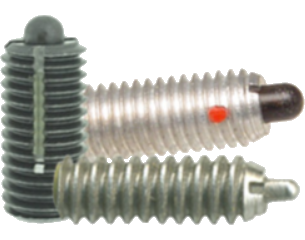
Plungers are commonly used for workpiece positioning applications. Consisting of a rod-shaped body that may or may not feature external threading, they can “lock” and position parts in place. You can find plungers in countless machines. While most of them serve the same purpose, though, there are several different types of plungers. This post breaks down four of the most common types of plungers.
#1) Spring
Spring plungers are characterized by the use of a spring. They still have the same rod-shaped body as most other plungers. Within this body, however, is a compression spring. The compression spring applies pressure to the nose so that it remains in place. Spring plungers can be inserted into machines or parts, after which the nose will remain stationary thanks to the spring.
#2) Ball
In addition to spring plungers, there are ball plungers. Also known as ball detent plungers, they feature an enclosed ball on one end. The ball will protrude partially out of the end. Upon inserting a ball plunger into a machine or part, it will remain in place until a sufficient amount of pressure is applied. Applying pressure to the ball plunger will force the ball to retract, in which case the ball plunger can be removed from the machine or part.
#3) Press Fit Ball
There are also press fit ball plungers. Press fit plungers are a subtype of ball plungers. Like traditional ball plungers, they feature a ball on one end. Press fit ball plungers differ from traditional ball plungers, however, by their lack of threading. Traditional ball plungers are designed with external threading. The body of a traditional ball plunger has threading, allowing it to be screwed into the threaded hole of a machine or part. Press fit ball plungers don’t have threading. Rather, they are designed to be “pressed” into a hole. Press fit ball plungers are typically used with nonmetal materials like wood or plastic.
#4) Indexing
Finally, there are indexing plungers. Also known as hard retractable plungers, indexing plungers feature a handle that can be pulled to remove them. Indexing plungers are fast and easy to use. When you pull the handle, the indexing plunger’s nose will retract into the body, thus allowing you to remove it from the machine or part with which it’s used. Spring, ball, press fit ball and indexing are four of the most common types of plungers,
